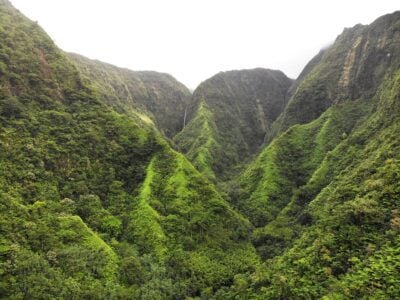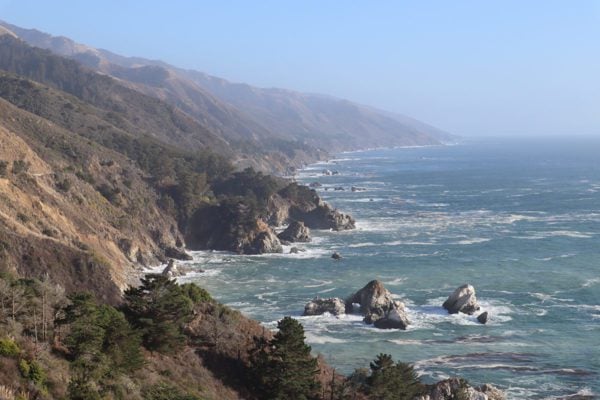2 Weeks In Utah Road Trip Itinerary
Beginning in Zion National Park and ending 400 miles east in Moab, a road trip in Southern Utah’s stunning desert is a feast for the eyes as it is for one’s soul. In this two weeks in Utah itinerary, we’ll cover all the national parks collectively known as the “Mighty Five” and also explore a hidden gem that rewards curious road trippers.
This Utah road trip itinerary is primarily based on my experience during a five-week road trip in the American Southwest. I spent most of my time in Southern Utah, visiting the various parks, driving on backcountry roads, and putting my legs to work on miles of hiking trails.
Several sections comprise this two weeks in Utah road trip itinerary:
- Zion National Park (3 days)
- Bryce Canyon National Park (2 days)
- Grand Staircase-Escalante National Monument (2 Days)
- Capitol Reef National Park (2 days)
- Arches National Park (2 days)
- Canyonlands National Park (3 days)
2 Weeks in Utah Itinerary Map
Here’s the driving route we’ll follow on this 14-day Utah itinerary. Simply click on the image to open it in Google Maps.
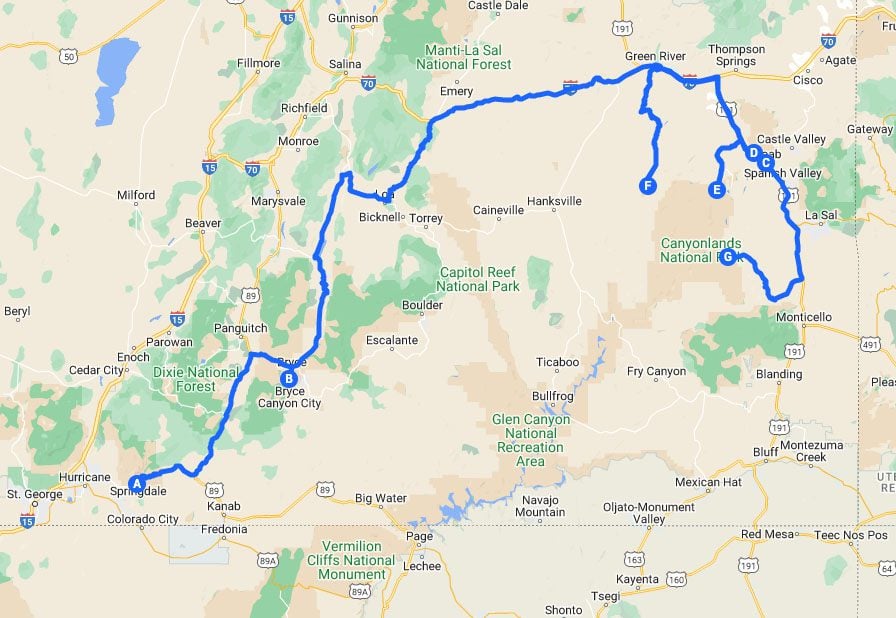
Additional Resources
Check out in-depth national park guides, sample itineraries, essential planning tips, and more on the Southern Utah travel guides collection, as well as additional travel guides to America’s Southwest.
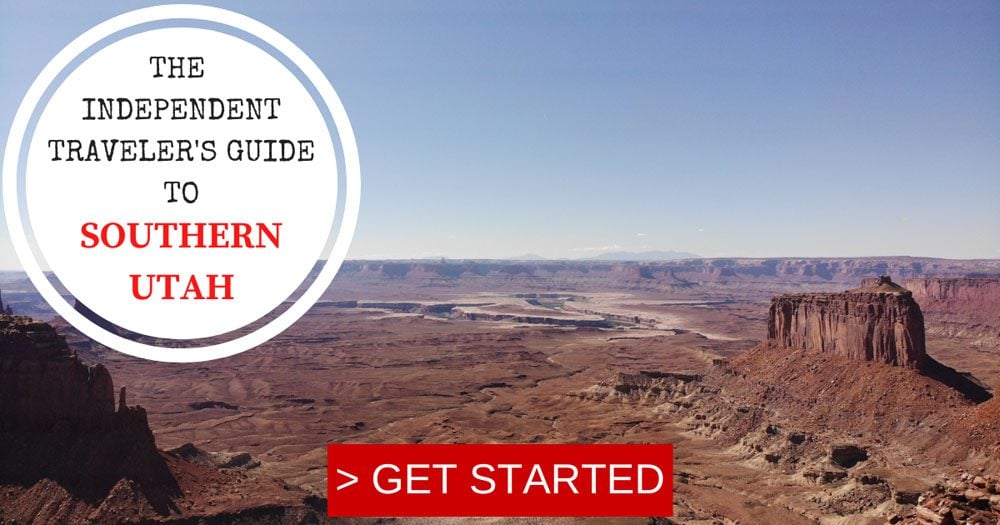
Before hitting the road, here are a few tips to keep in mind:
- Inspect your spare tire and parts (even on a rental car), and check your oil and other essential fluids.
- Fill your gas tank before it dips below 50%.
- Carry more water and food than you think you’ll need.
- Download offline navigation maps but also carry a physical map of the area.
- Purchase a copy of the Moon Utah travel guide to prepare for the trip and learn about the region.
- Carry a USB car charger.
- Chat with park rangers to “sanity check” your driving and travel plans.
- Stay on paved roads and only drive on dirt roads that suit your vehicle.
- Familiarize yourself with what to do when your car overheats.
- Carry a first aid kit and a flashlight.
- Do your best to avoid driving at night.
- Upgrade to All Trails Pro and download trail maps to your smartphone for offline use.
- Think carefully about the travel gear you’ll need: clothing, sun protection, hiking gear, camping equipment, etc.
- Prepare for the elements: hot, cold, dry, and wet conditions.
- Purchase the America the Beautiful Pass to save on paying park fees.
Zion National Park (3 Days)
Zion National Park is an ideal starting point for this two-week Utah road trip thanks to its proximity to Las Vegas, which is about 2.5 hours west of Zion. With over 4.5 million annual visitors, Zion National Park is the most popular national park in Utah, but most visitors turn their attention to the relatively small Zion Canyon. Therefore, spending three days in Zion allows not only to explore Zion Canyon but also to escape the crowds in the park’s more remote Kolob Canyons area.
If driving from the Grand Canyon to Zion National Park, consider spending a night in Page, Arizona, to explore Antelope Canyon and Horseshoe Bend.
Where to Stay?
If you want to stay inside Zion Canyon, the Zion Lodge or the Watchman and South Campgrounds are the only options. Bordering Zion Canyon, the town of Springdale is an ideal place to use as a base, thanks to its wide selection of motels and the ability to use a free park shuttle connecting the town with the visitor center. Further out, La Verkin and Hurricane are also ideal if you don’t mind driving a bit. Finally, the campground at Lava Point is ideal for exploring the Kolob region.
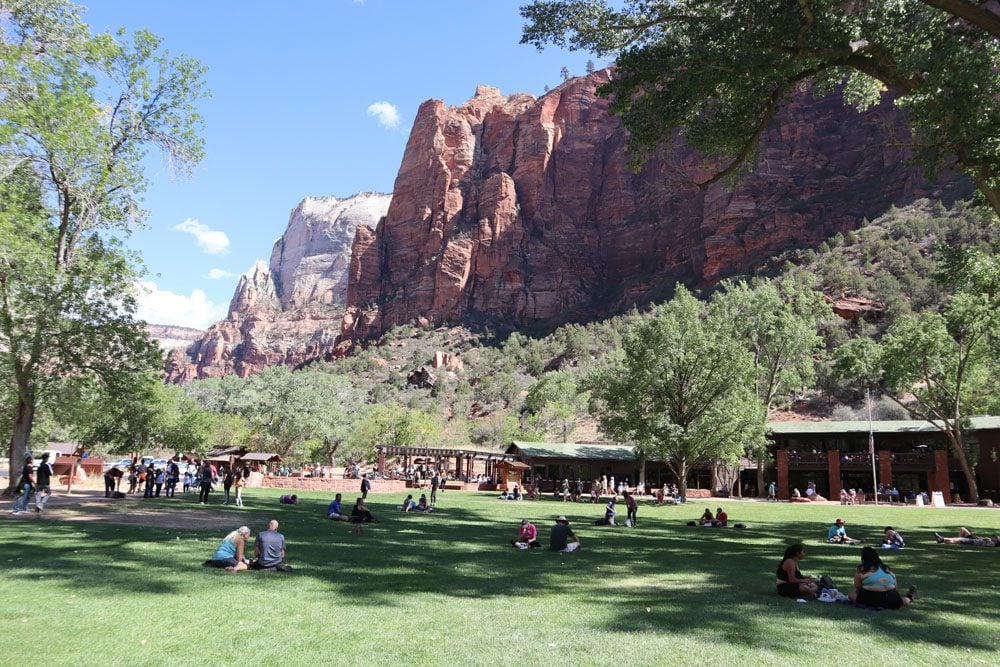
Here are all the Zion National Park region accommodation options that can be booked online via Booking.com.
What to Do?
Spend day one using the free park shuttles to explore Zion Canyon. Start at the very last stop at the Temple of Sinawava, which marks the starting point for Riverside Walk. This easy trail is an optimal early morning activity as the sun has yet to illuminate the canyon floor fully. The Riverside Walk ends where the famous Narrows Trail begins, but you’ll need to come prepared with special gear to hike part of this trail (you can rent outside the visitor center). In the afternoon, hike to the Emerald Pools and, if there’s enough time and energy, wrap up the first day with the challenging yet short Watchman Trail.
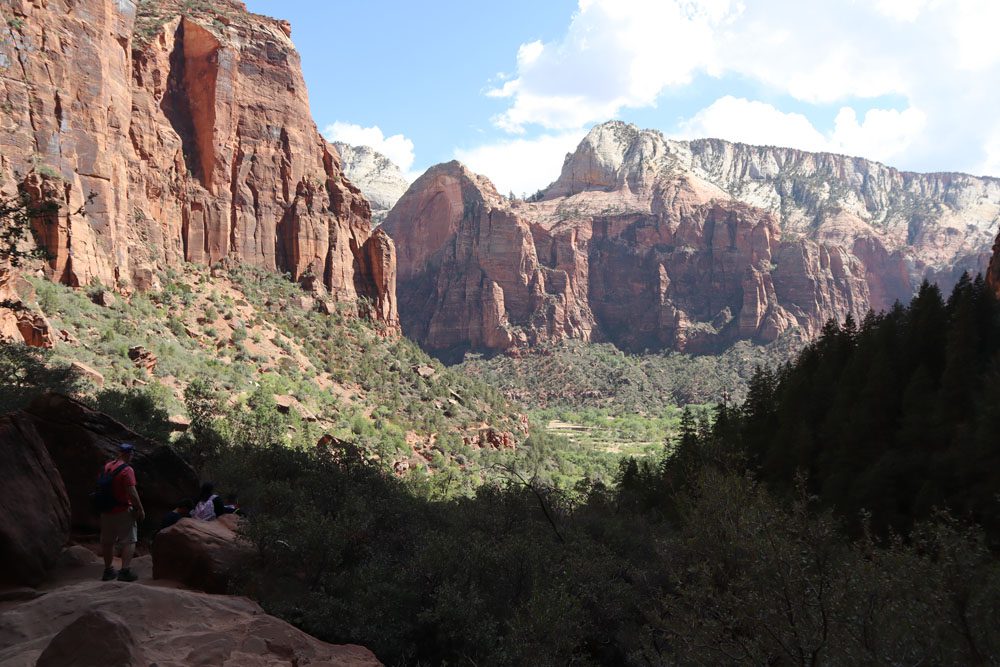
Day two in Zion NP starts with hiking the Angel’s Landing Trail, Zion’s star attraction. Be sure to secure a hiking permit, as park officials have recently implemented a new system to ease congestion on this popular trail. Then, after some rest on the lawn in front of the Zion Lodge, head back to your car and drive on the scenic Zion-Mount Carmel Highway to pick up the short Canyon Overlook Trail for a final memorable vista of Zion Canyon.
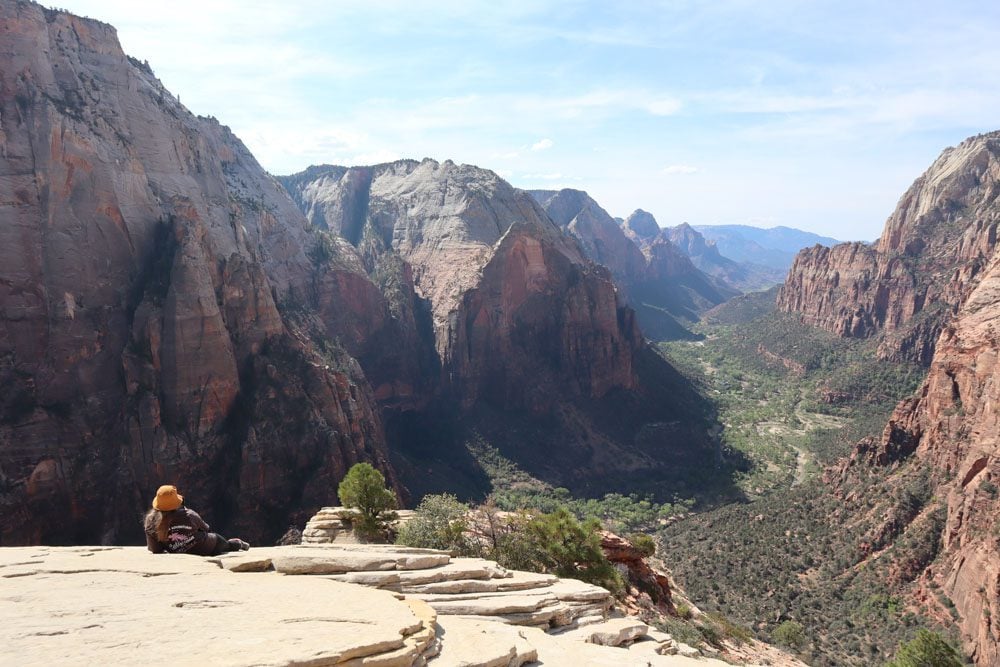
Day three in Zion is a road trip to explore its lesser-known and lesser-visited Kolob region. First, take Kolob Terrace Road and try to make it to the Kolob Reservoir. Stop at scenic viewpoints along the way and hike on short or long trails to spice up the day. Alternatively, take Interstate 15 to Kolob Canyons and spend the day exploring these red-colored canyons that see fewer visitors than Zion Canyon.
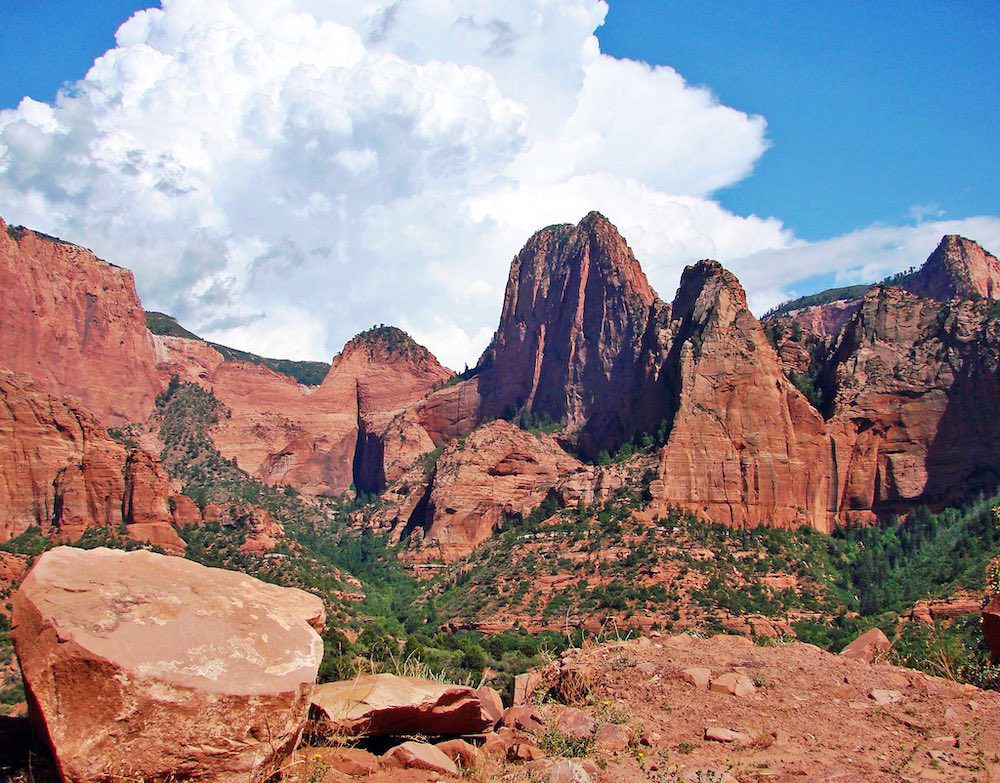
Here’s a detailed three-day Zion itinerary that takes an in-depth look at how to spend three days in the national park. For a quick read, here’s a list of the top 10 things to do in Zion.
Bryce Canyon (2 Days)
Bryce Canyon is only 85 miles from Zion, so it’s an ideal next stop on this two weeks in Utah itinerary. Contrary to popular belief, Bryce Canyon is not a canyon but a series of amphitheater-like depressions in which erosion created the famous hoodoos. Bryce Canyon is the smallest national park in Utah, so a one-day visit is sufficient if you aren’t planning to hike. However, a two-day visit is perfect to see all its top highlights without feeling rushed.
Where to Stay?
Most visitors to Bryce Canyon stay in Bryce Canyon City, a small town purposely built to serve the national park. Inside the park, the Lodge at Bryce Canyon is perfectly located next to Sunset Point, while the North or Sunset Campgrounds are ideal for campers. If you can’t find anything close to the park, check what’s available nearby in Tropic.
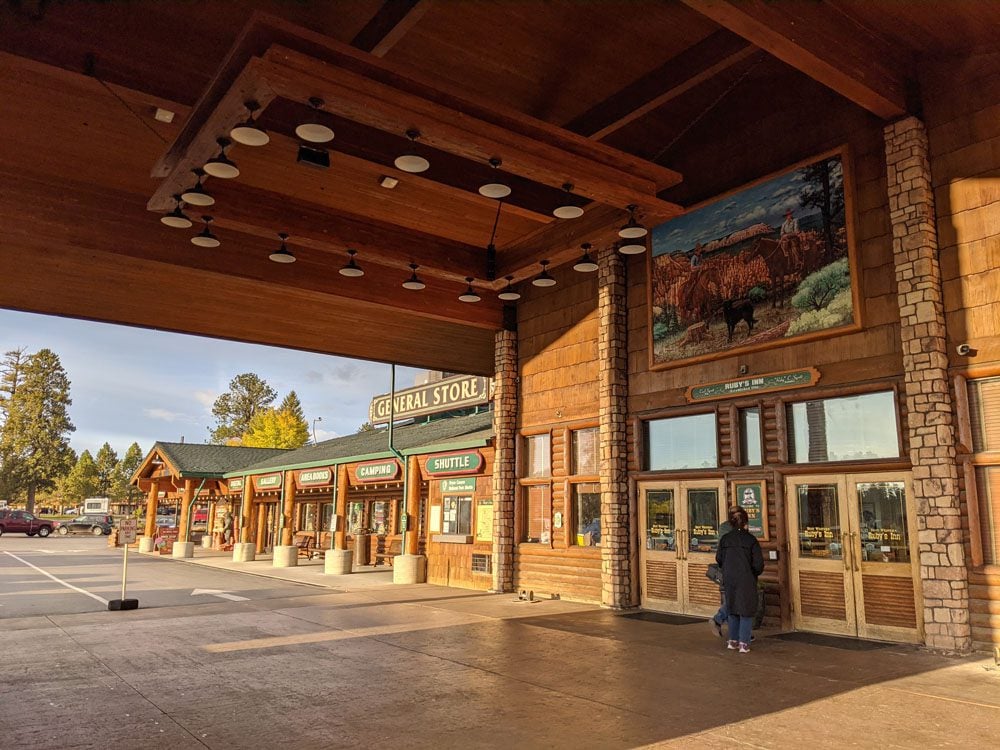
What to Do?
It takes about two hours to reach Bryce Canyon from the Springdale side of Zion. There aren’t any must-see attractions on the way but stop for a nice photo of cars driving through the Red Canyon Arch. Spend the rest of the day exploring the Bryce Amphitheater. This is the busiest section of the park, but for good reasons.
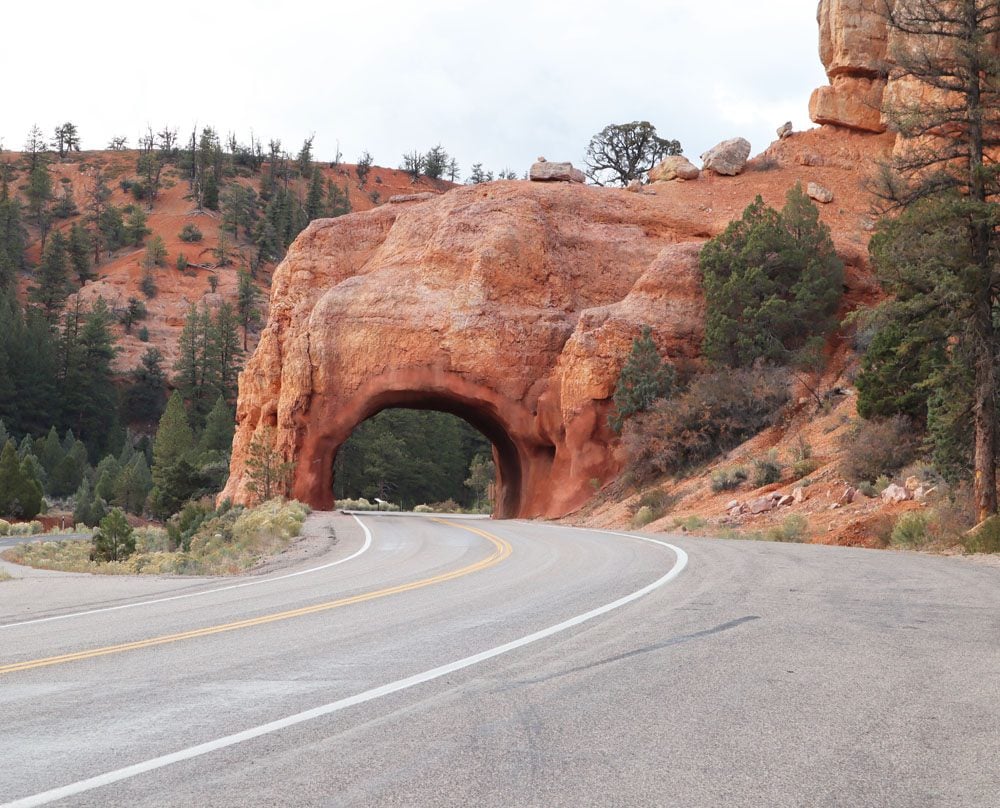
Start your visit at Sunset Point and spot Thor’s Hammer among the thousands of hoodoos beneath your feet. Then use the Bryce Canyon Rim Trail and walk along the rim to Sunrise Point. From here, either use your car or head back on the rim trail, continuing beyond Sunset Point to Inspiration Point and Bryce Point. The latter two are among the most impressive viewpoints in Bryce Canyon. If it makes sense, stick around for sunset at Sunset Point and make reservations at Ebenezer’s Barn & Grill for their dinner and country music show.
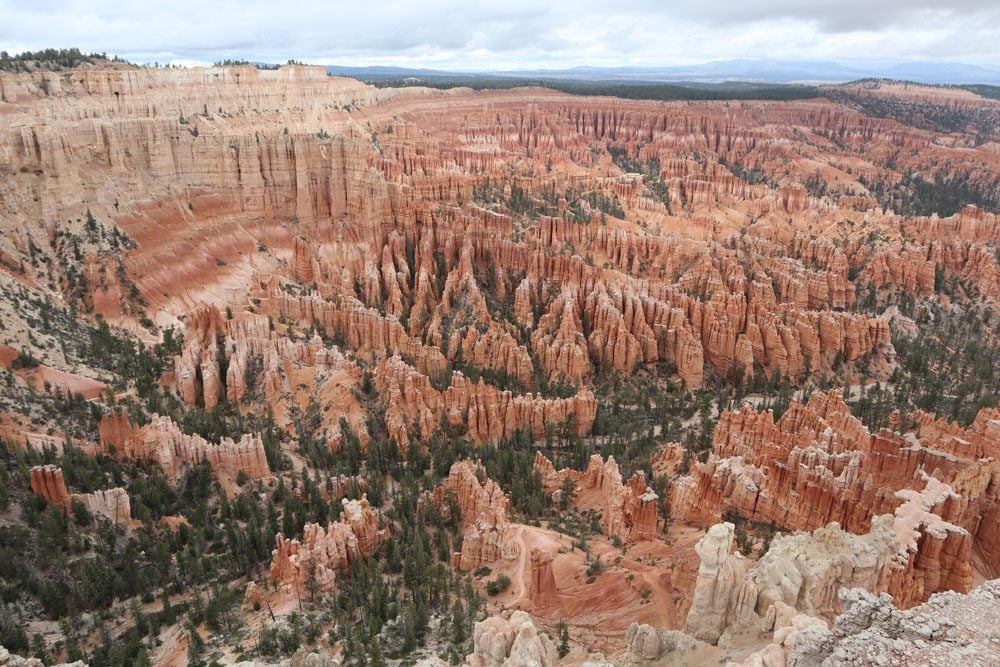
On day two in Bryce Canyon, get an early start to beat the crowds and head back to Sunset Point. It’s now time to explore the amphitheater floor by putting your legs to work. Pick up the easy Navajo Loop Trail and squeeze through Wall Street. On the other side, connect with the moderate Peekaboo Loop Trail, and ascend back to the rim using the easy Queen’s Garden Trail.
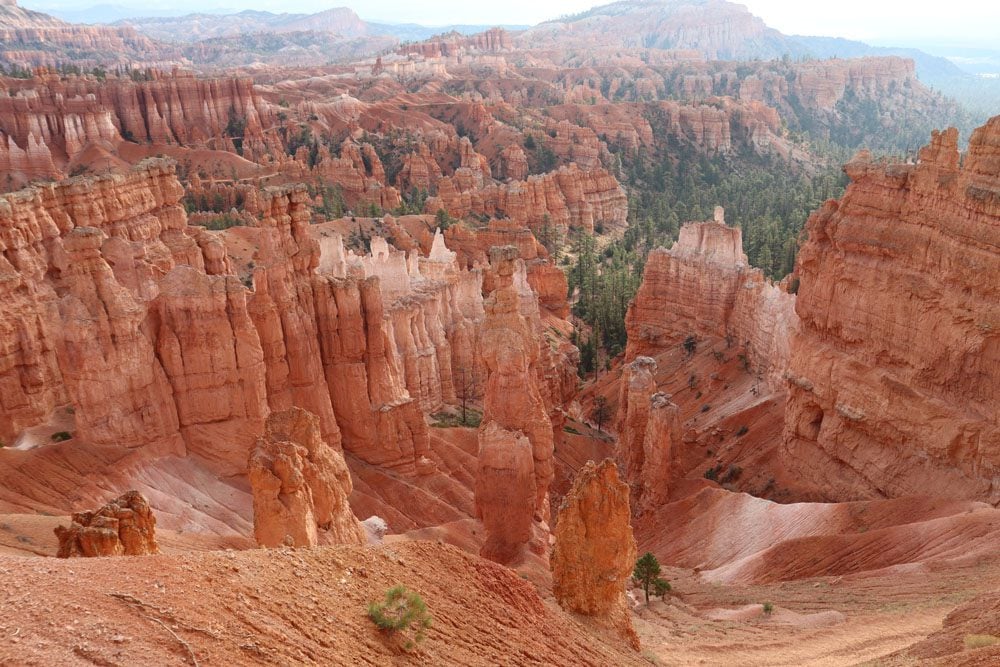
Back in the car and after a well-deserved break (try the lodge’s cafe or restaurant), drive the length of Bryce Canyon Road and stop at interesting scenic viewpoints such as the Natural Bridge and Rainbow Point. Use the rest of the day to escape the crowds at Fairyland Canyon. Find some serenity at Fairyland Point and consider hiking all or part of the Fairyland Loop Trail.
Here’s an in-depth two days in Bryce Canyon itinerary and a quick rundown of the top things to do in the national park.
Grand Staircase-Escalante (2 Days)
The third stop on our two weeks in Utah road trip takes us to the only non-national park member on this itinerary. Lying east of Bryce Canyon, Grand Staircase-Escalante National Monument extends over 1.9 million acres of sandstone canyons, plateaus, cliffs, and unique rock formations. The immense national monument has few services or paved roads, so preparation is key. But with a bit of time and a high-clearance AWD vehicle, you can experience its wilderness.
Where to Stay?
The small town of Escalante is the best option, with Boulder a close second. Additional options in nearby towns might also be available. For camping, Calf Creek is an excellent spot.
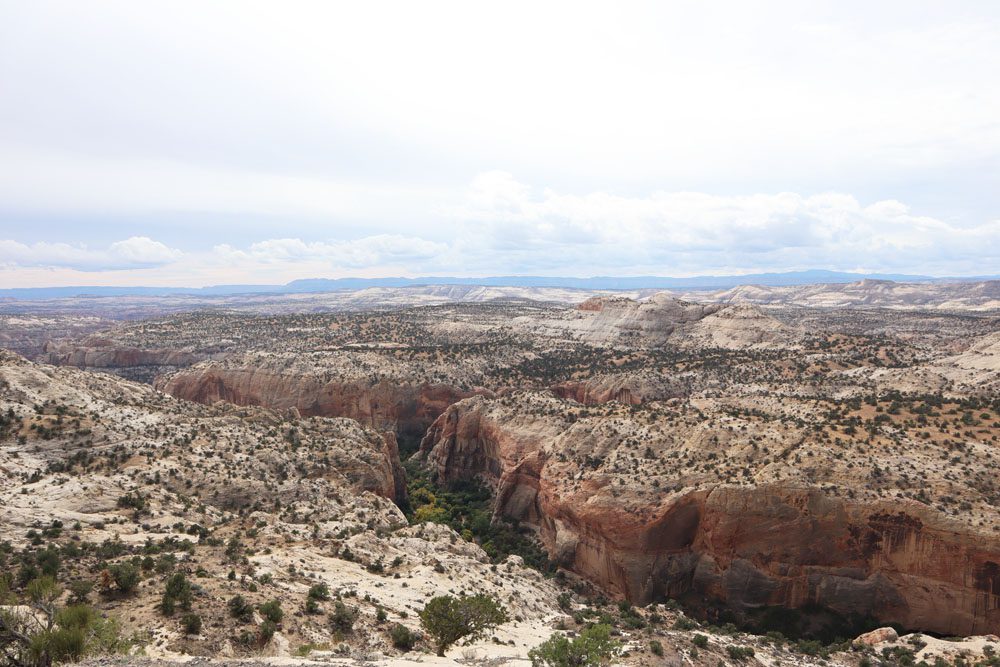
What to Do?
Get an early start and leave Bryce Canyon on Scenic Byway 12, stopping along the way at scenic viewpoints such as Powell Point and Hole in the Wall Wayside. If you have a high-clearance AWD, explore the area’s slot canyons. The Zebra and Tunnel Slots are closer to Highway 12. You can shorten the hike by visiting only Zebra Canyon, while the shorter hike to Peek-a-Boo and Spooky Slot Canyon is further away from the highway along a lonely dirt road. Check out Devils Garden (Metate Arch) between the two trails.
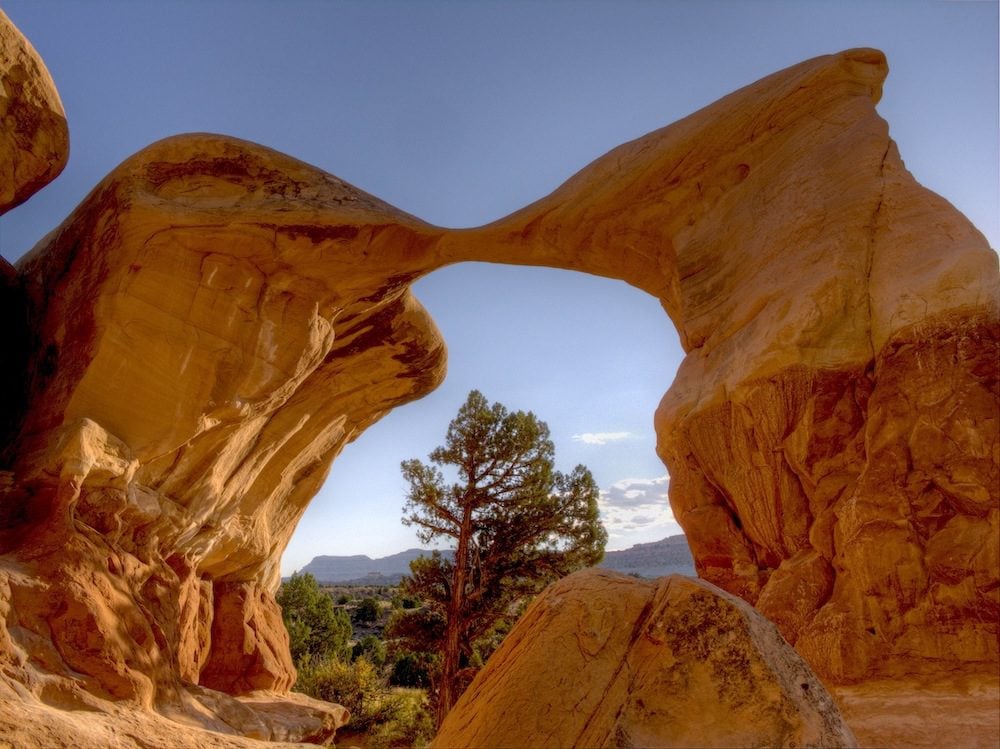
On day two in Grand Staircase-Escalante, continue on Highway 12 toward Boulder and stop at interesting viewpoints such as Head of the Rocks Overlook and Boynton Overlook. Then, hike to Lower Calf Creek Falls and splash in this desert oasis. Beyond Boulder, Highway 12 quickly gains elevation up to around 9,000 feet, and the desert landscape momentarily gives way to forests thick with aspen trees and cattle. Be sure to stop at Homestead Overlook to enjoy sweeping views of the area.
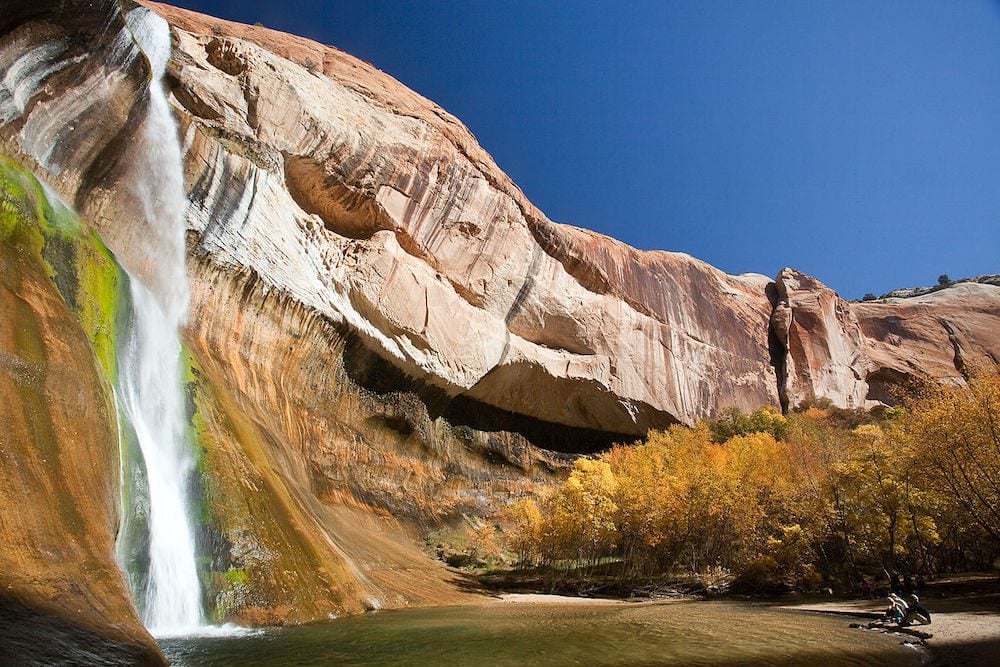
In the town of Torrey, head east on Scenic Byway 24 towards Fruita and enter Capitol Reef National Park. The scenery on this stretch of desert road is magnificent, with a few worthwhile stops at Chimney Rock, Panorama Point and its extension to Goosenecks Overlook, and the Fluted Wall. In Fruita, check out the historic schoolhouse and Gifford Homestead, then drive the length of the eight-mile scenic drive. If there’s time, you can continue to Capitol Gorge and hike to Pioneer Register or head back to Highway 24 to see the Petroglyphs Panel.
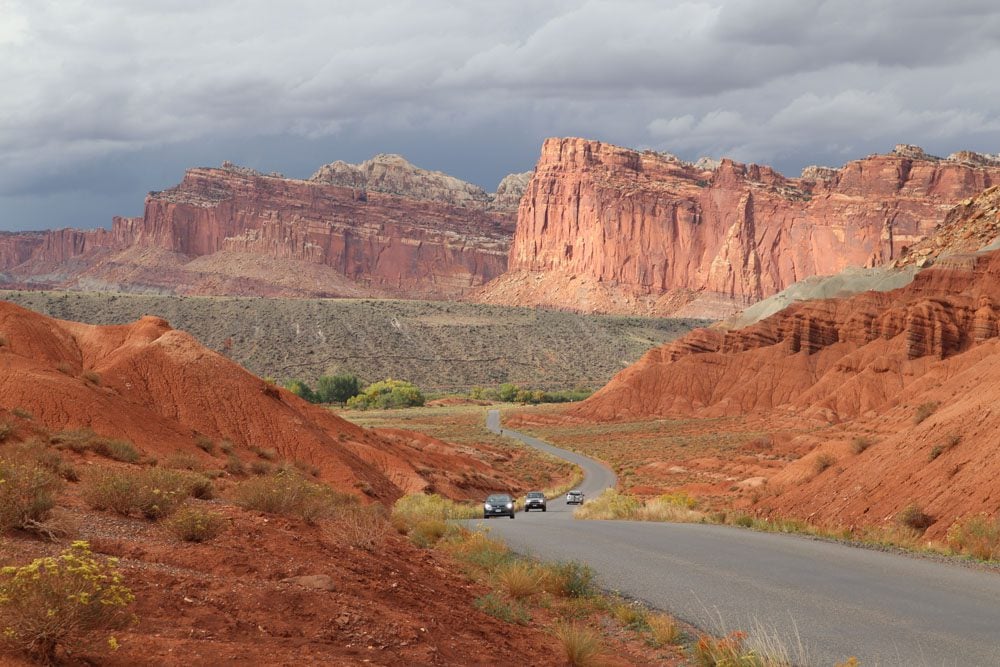
If you got an early start and finished hiking to Lower Calf Falls before noon (or skipped it entirely), consider a more exciting way to reach Capitol Reef. The Burr Trail is a 66-mile road connecting Boulder with Notom Road, which runs north to Highway 24 in Capitol Reef and south deep into Glen Canyon National Recreation Area. Be well-prepared for this drive which, for the most part, is on a dirt road. Highlights include the Burr Trail Switchbacks, the Upper Muley Twist Canyon Trail, Strike Valley Overlook, and the hike to Surprise Canyon.
Capitol Reef National Park (2 Days)
Our fourth stop on this Utah itinerary takes us to the third national park. Capitol Reef is the second-largest national park in Utah but one of its least visited. With slightly more infrastructure than its neighbor, Grand Staircase-Escalante, exploring Capitol Reef is not a walk in the park, but many travelers consider this lesser-known gem their favorite. Capitol Reef is known for its slot canyons, natural bridges, and sandstone arches.
Where to Stay?
Most often, visitors to Capitol Reef “rough it out” by camping in the backcountry or at the optimally located Fruita Campground. However, if camping is not what you’re after, the towns of Caineville and Torrey are the best options.
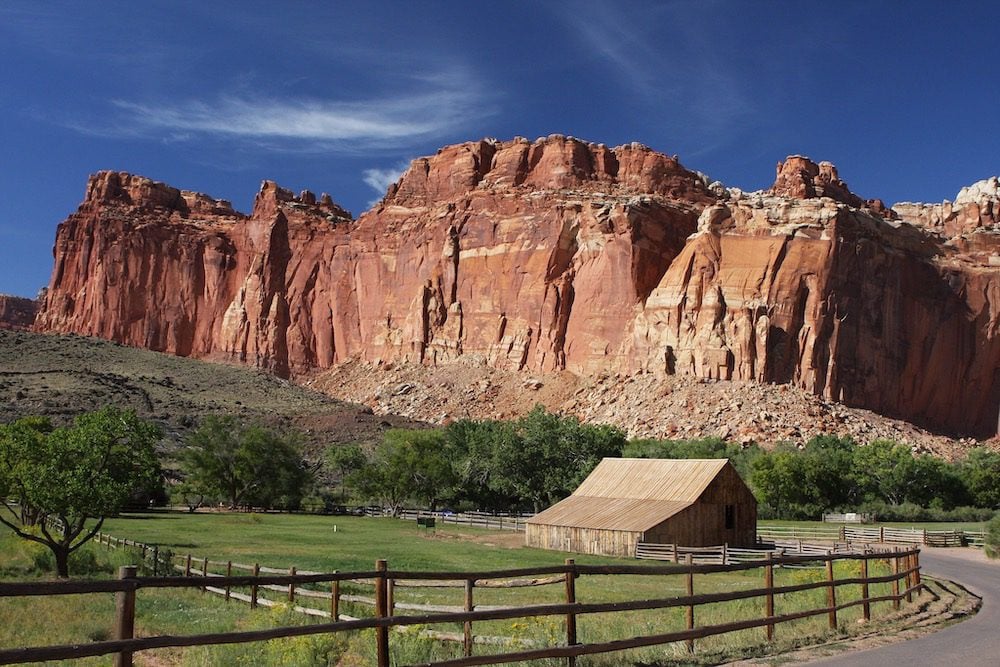
What to Do?
On day one in Capitol Reef, get a very early start and drive the Cathedral Valley Loop, a 58-mile scenic drive on a dirt road just north of Fruita. You’ll need a high clearance AWD vehicle or a 4WD unless otherwise advised by park rangers. If there isn’t enough time to complete the loop, drive to the Temple of the Sun and the Temple of the Moon.
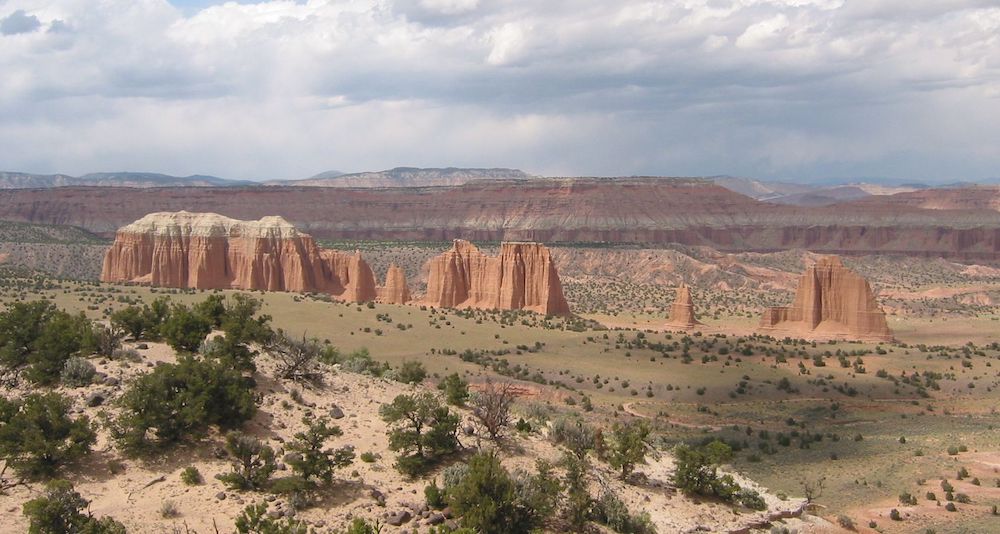
Alternatively, drive from Fruita on Norton Road and check out the legendary Burr Trail switchbacks if you didn’t take this route to Capitol Reef from Grand Staircase-Escalante (see the highlighted box in the previous section). Check road conditions with park rangers before attempting the drives for both options.
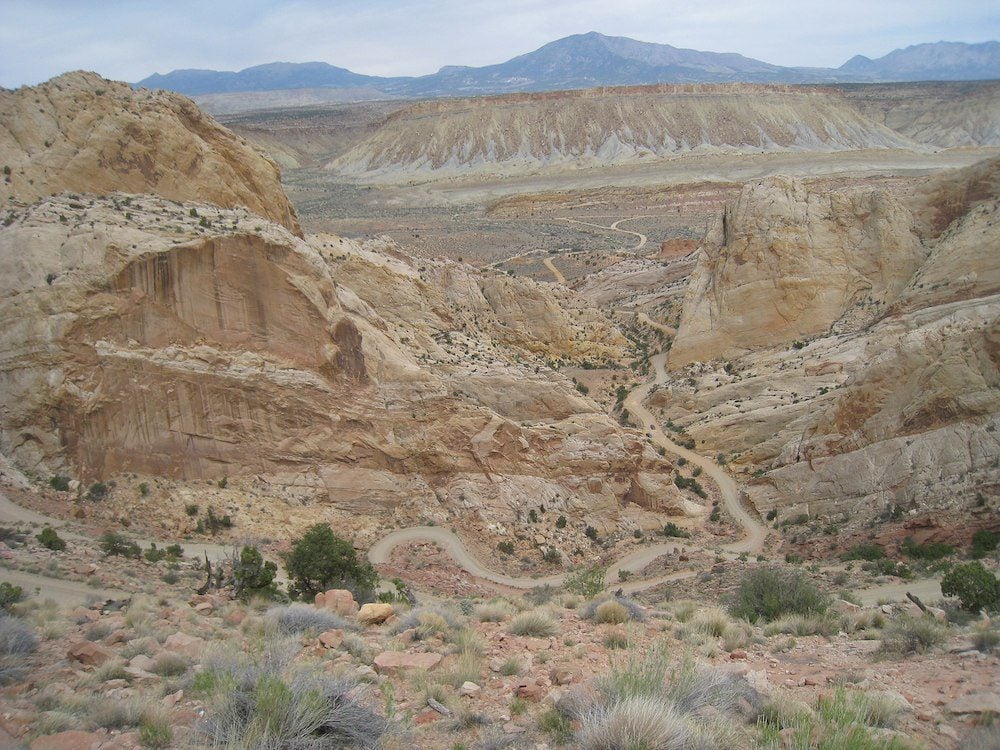
Spend day two in Capitol Reef, inching closer to our final base on this Utah road trip in Moab, 2.5 hours east of Fruita (150 miles). Hike the Hickman Bridge trail to see this 133-foot natural bridge, and extend the hike with a detour to Hickman Bridge Overlook and even further to Rim Overlook. Alternatively, hike the easy Grand Wash Trail and combine it with the Cassidy Arch Trail for a slightly longer adventure.
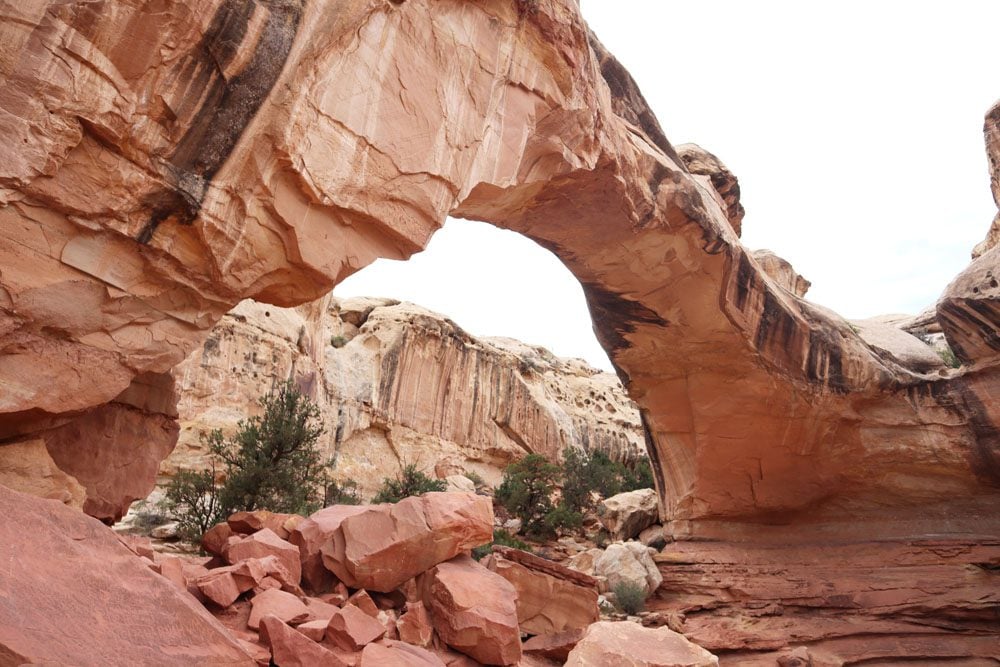
From Fruita, continue on Scenic Byway 24 to Moab. If there’s enough time left and you have the right type of car, consider checking out the seemingly out-of-place Factory Butte. Beyond the town of Hanksville, the road is as straight as an arrow for the most part until meeting Interstate 70.
Arches National Park (2 Days)
The next stop on this two-week Utah road trip is in Arches National Park, one of my personal favorites. Arches is one of the smallest national parks among the “Mighty Five,” but it’s also one of the most popular. Recently, park officials implemented a timed entry reservation system, so careful planning is needed. Apart from hosting the world’s highest concentration of natural rock arches, the park contains stunning desert scenery that often attracts Hollywood directors.
Where to Stay?
Moab is the optimal base for a visit to Arches and Canyonlands National Parks. The small city has a lot of charm and useful visitor services, such as hotels and restaurants. The campground at Devils Garden is the only accommodation option inside Arches NP, but it is challenging to reserve a spot in peak months. If you’re out of luck at Devils Garden, look for other camping options in BLM campgrounds along State Route 128.
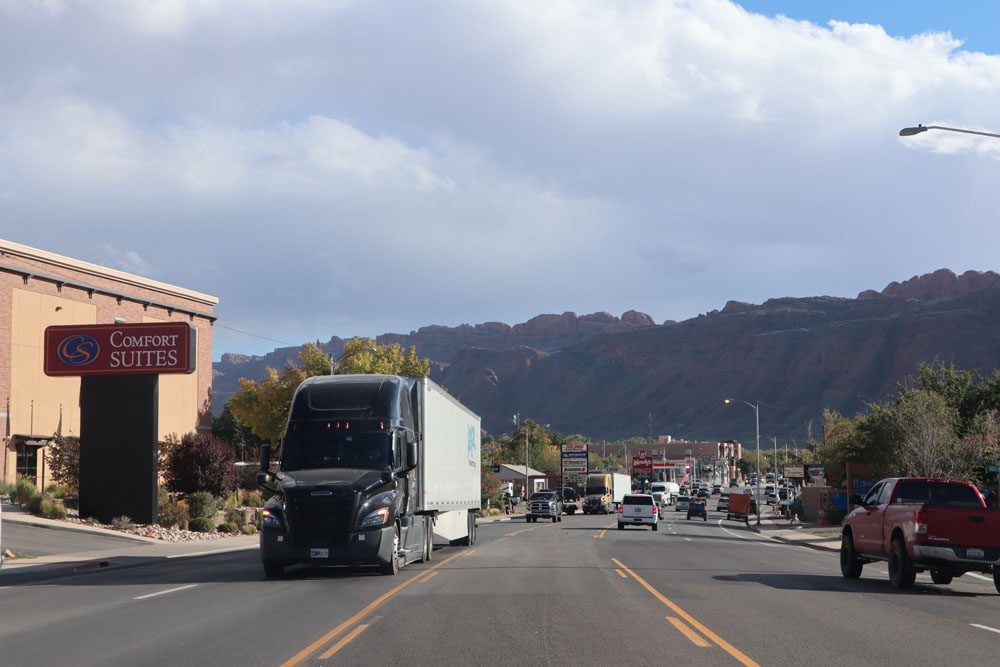
What to Do?
Spend the first day in Arches National Park, focusing on the Devils Garden and Delicate Arch sections. Get an early start and perhaps watch the morning colors from the La Sal Mountain Viewpoint. Then, continue along the 18-mile scenic drive to its northern tip at Devils Garden and hike the length of the Devil’s Garden Trail. This trail loops around an area of the national park with the highest concentration of natural arches. Highlights include Landscape Arch, the largest in the park, Double O Arch, and the wild Primitive Trail on the return leg.
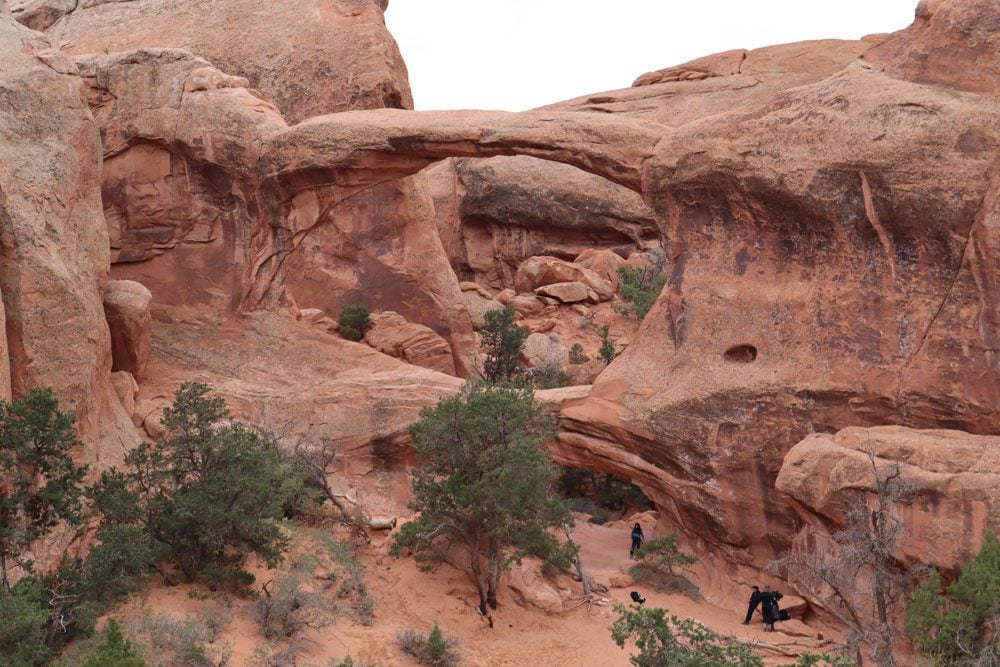
In the afternoon, patiently look for a parking spot at the Delicate Arch trailhead. Hiking to Delicate Arch is the top highlight in Arches NP, though some sections of the trail are challenging. Back in the car, check out the bizarre-looking Balanced Rock, and then spend the rest of the afternoon around the Courthouse Towers and Park Avenue before heading back to Moab.
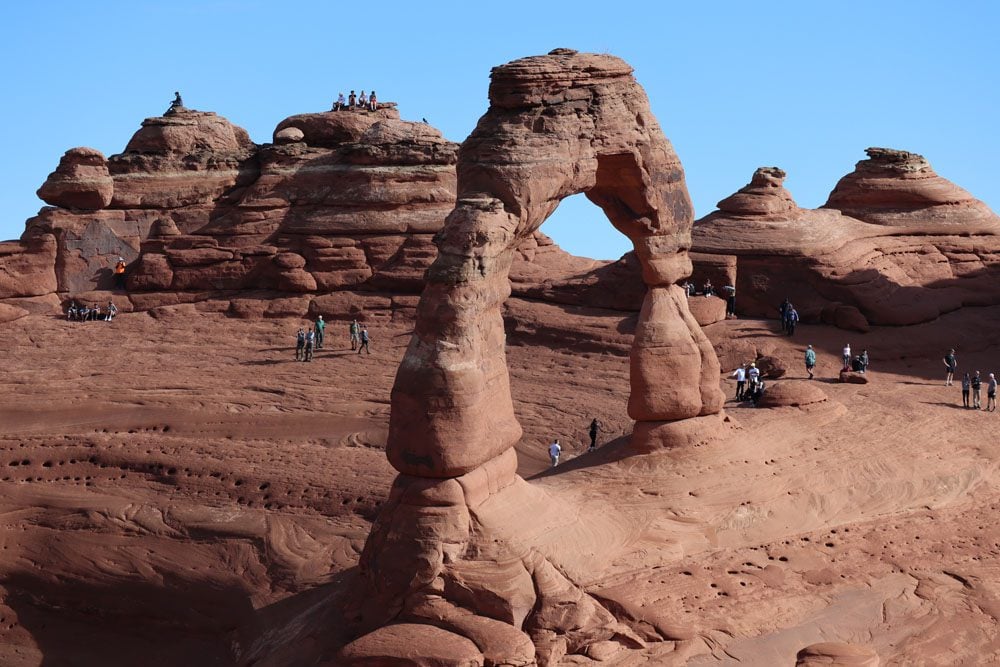
On the second day in Arches, take the eight-mile dirt road to Klondike Bluffs and complete the Tower Arch Trail. Then, devote the afternoon to the Windows Section. Start at the Garden of Eden Viewpoint to see the Parade of Elephants, an impressive series of seemingly extraterrestrial sandstone statues. Next, continue to the end of the paved road to hike the Windows Loop Trail, later crossing the road for the short trail to Double Arch.
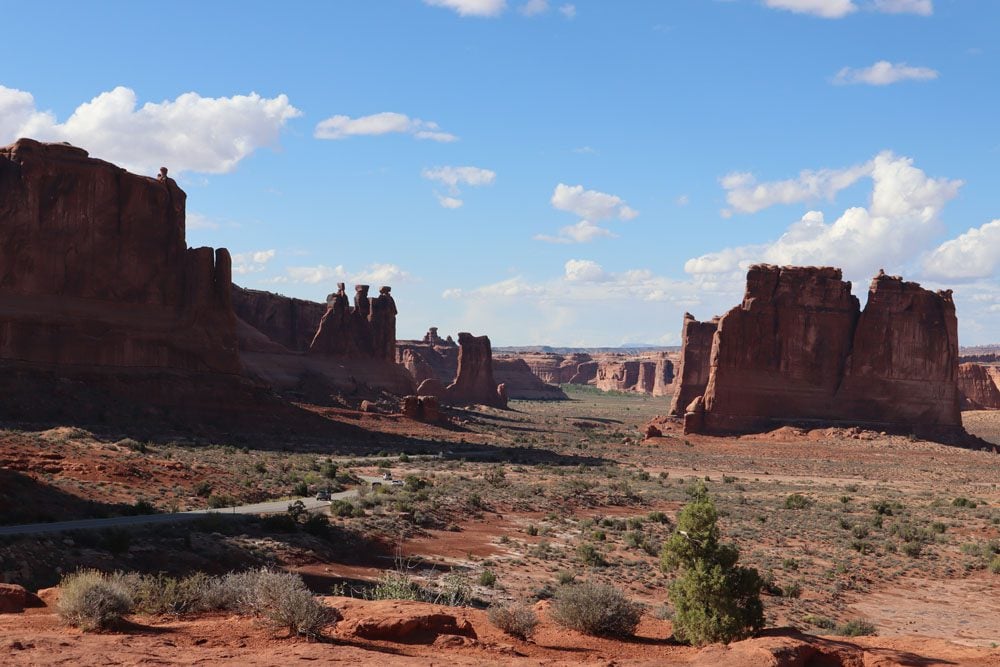
Here’s a detailed itinerary for spending two days in Arches National Park and a quick rundown of the top things to do.
Canyonlands National Park (3 Days)
We’ll end this two-week Utah itinerary with an extended visit to Canyonlands National Park, Utah’s largest yet least-visited national park. Canyonlands is so colossal that it’s divided into four separate districts by the Green and Colorado Rivers, whose confluence is at the heart of the park.
Where to Stay?
Moab is an ideal base for exploring Canyonlands National Park. However, it’s only close to the Island in the Sky district. If you want to shorten the distance to Horseshoe Canyon, consider moving to Green River for one night, and if you’re heading to the Needles, staying in Monticello or La Sal will shave off some driving time. See if there’s space available at the Island in the Sky or the Needles campgrounds for camping options. If there’s none, look for a free spot in BLM campgrounds outside Moab along State Route 128.
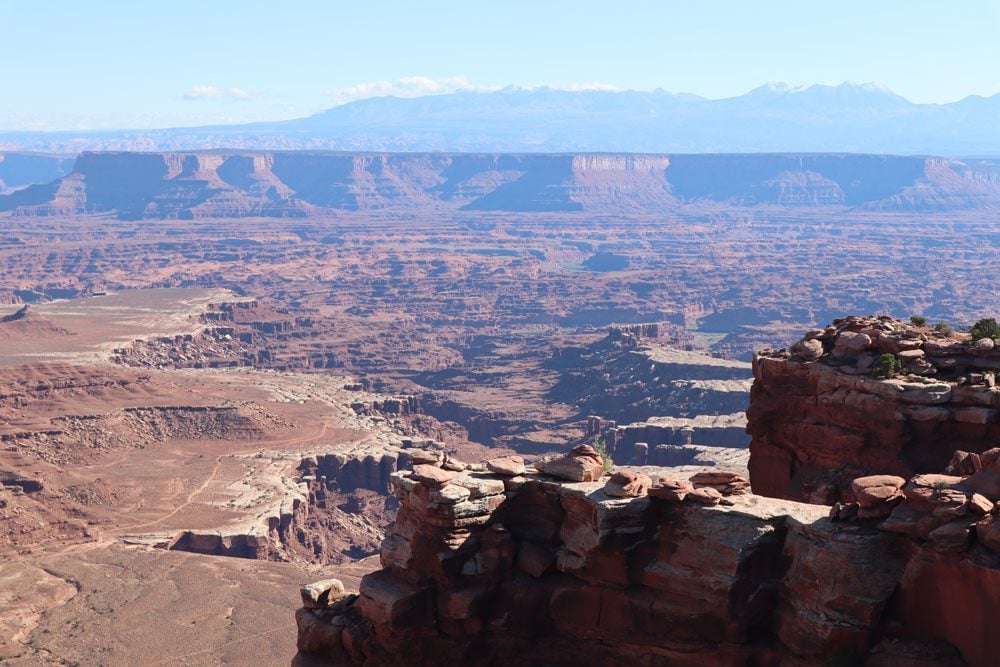
Here are all the Moab, Monticello, La Sal, and Green River accommodations that can be booked online via Booking.com.
What to Do?
With three days to spend in Canyonlands, we’ll focus on three regions that are not connected to each other. However, if you have a 4WD, you could potentially spend the entire time “getting lost” in the remote and hard-to-access Maze district by camping in the backcountry.
Island in the Sky
Spend the first day in Canyonlands NP in Island in the Sky, the park’s most visited and accessible section. Island in the Sky derives its name from its commanding position on the edge of a 6,000-foot sandstone mesa, overlooking 100 miles of stunning Canyonlands scenery.
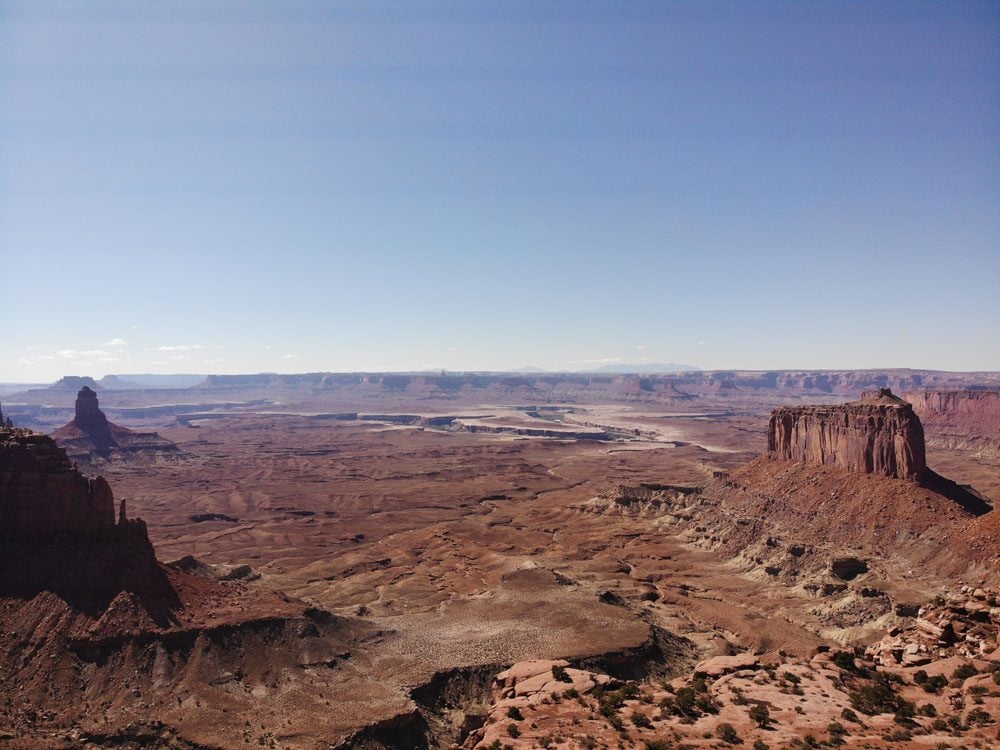
A 34-mile scenic drive makes Island in the Sky easy to explore. The drive offers access to many memorable scenic lookouts and trailheads. Spend the morning driving the length of the scenic drive. Start at Mesa Arch and enjoy morning colors shining through this natural window. Then, head to Grand View Overlook and hike the length of the Grand View Point Trail to better understand why they call it Island in the Sky.
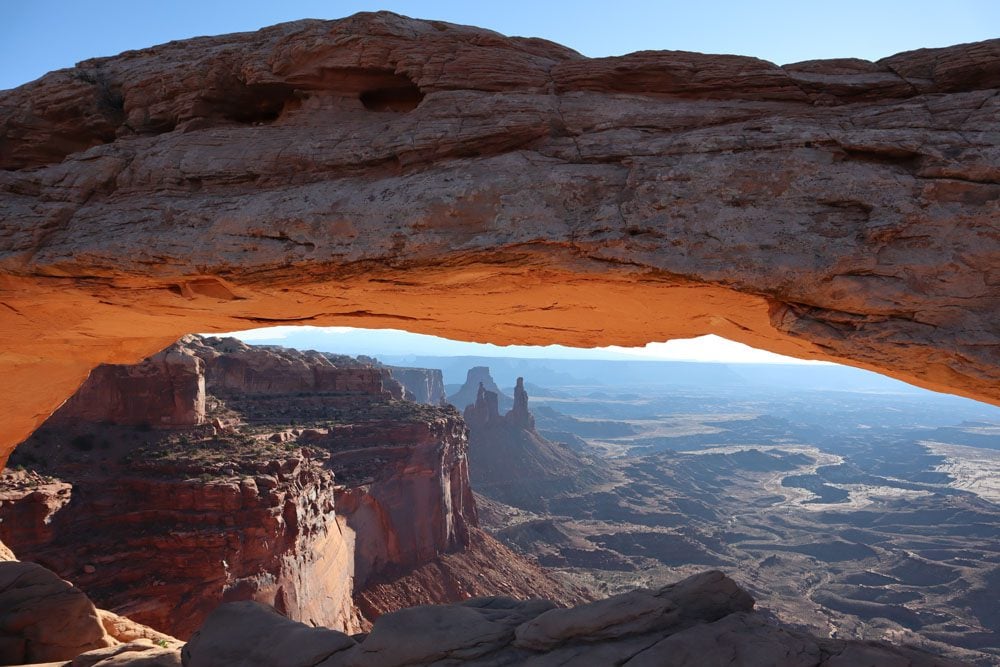
After the hike, continue to additional scenic spots, including Buck Canyon and White Rim Overlooks. At the Green River Overlook, witness how the serpent-like river shaped Canyonlands and then continue to Upheaval Dome to see the meteorite impact crater.
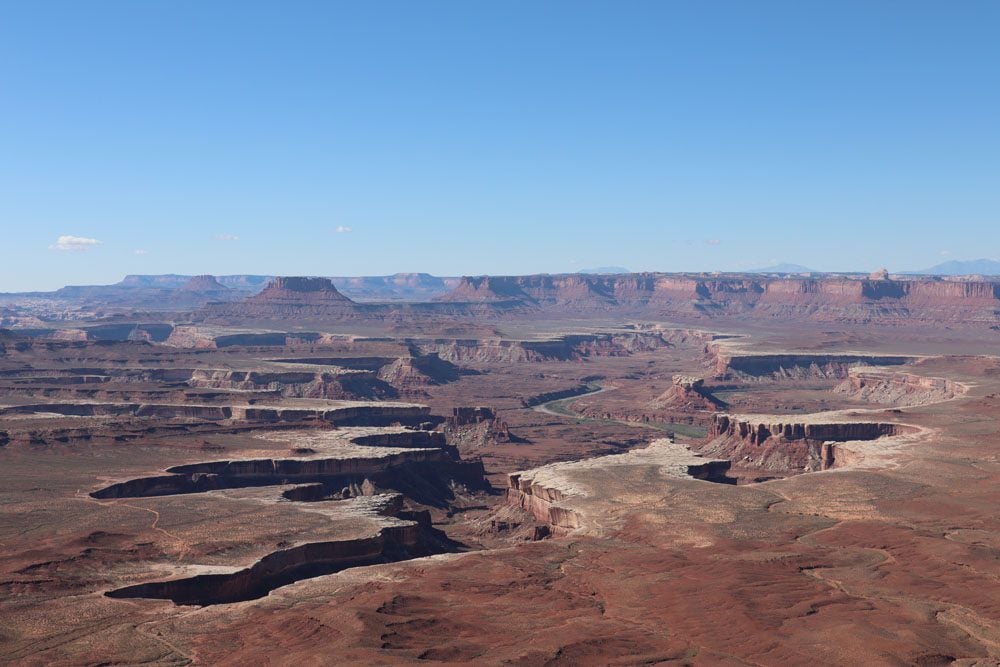
Spend the afternoon hiking one of Island in the Sky’s medium or long trails. Challenging trails descend over 1,000 feet from “the island” and lead to the famous 4WD-only White Rim Road. Remember, though, that what goes down must come up. Shorter trails like the Neck Spring Trail and Murphy Point Trail are easier options. Before returning to Moab, leave enough time for a glorious sunset next door at Dead Horse Point.
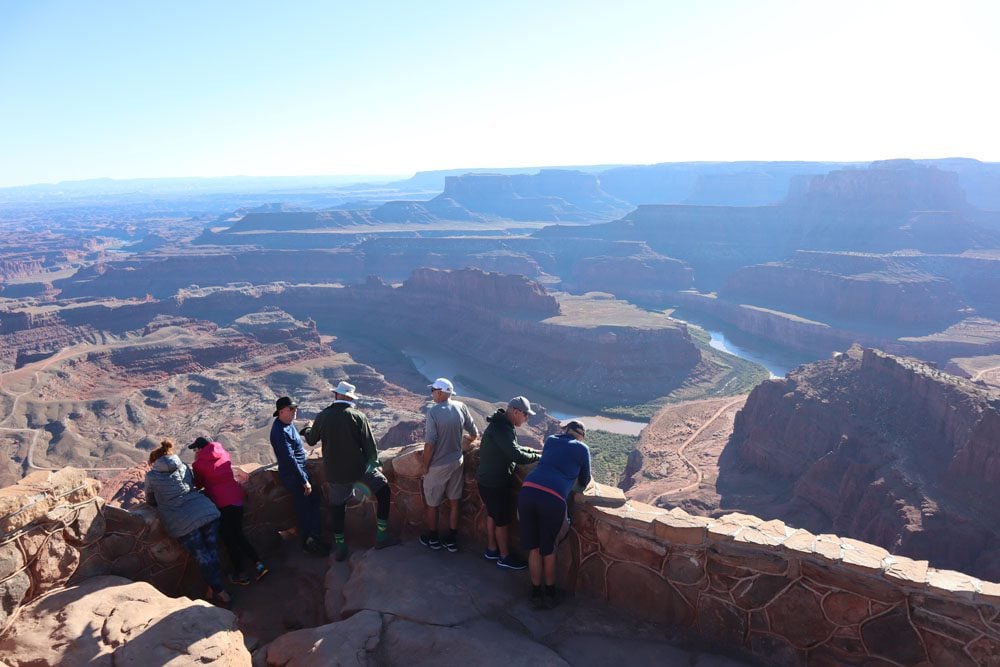
Horseshoe Canyon
On day two in Canyonlands, see some of North America’s most significant and magnificent rock art at Horseshoe Canyon. Getting here is quite challenging, taking about 2.5 hours from Moab or 1.5 hours from Green River. Most of the drive is on dirt roads suitable for regular cars if it hasn’t recently rained.
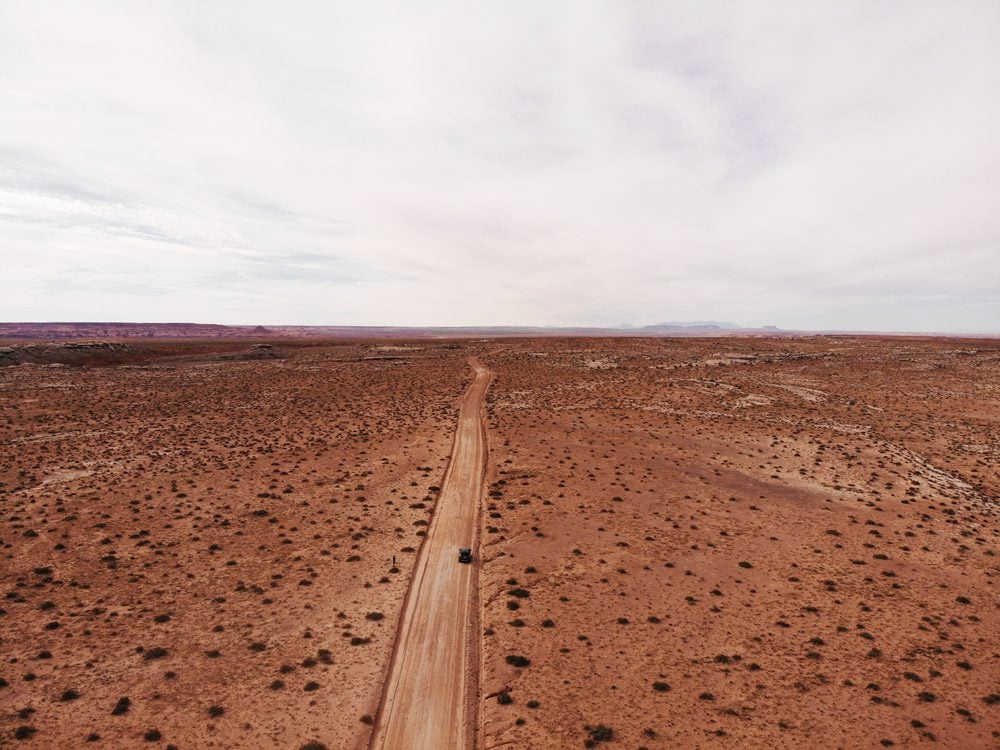
The goal is to hike the moderately difficult Horseshoe Canyon Trail, which leads to several galleries whose mysterious rock art is estimated at 3000-4000 years old. Researchers aren’t certain why the ancient hunter-gatherer tribes painted these figures or what exactly they collectively mean. Still, the feeling of hiking in this secluded canyon and seeing these ancient works is hard to describe.
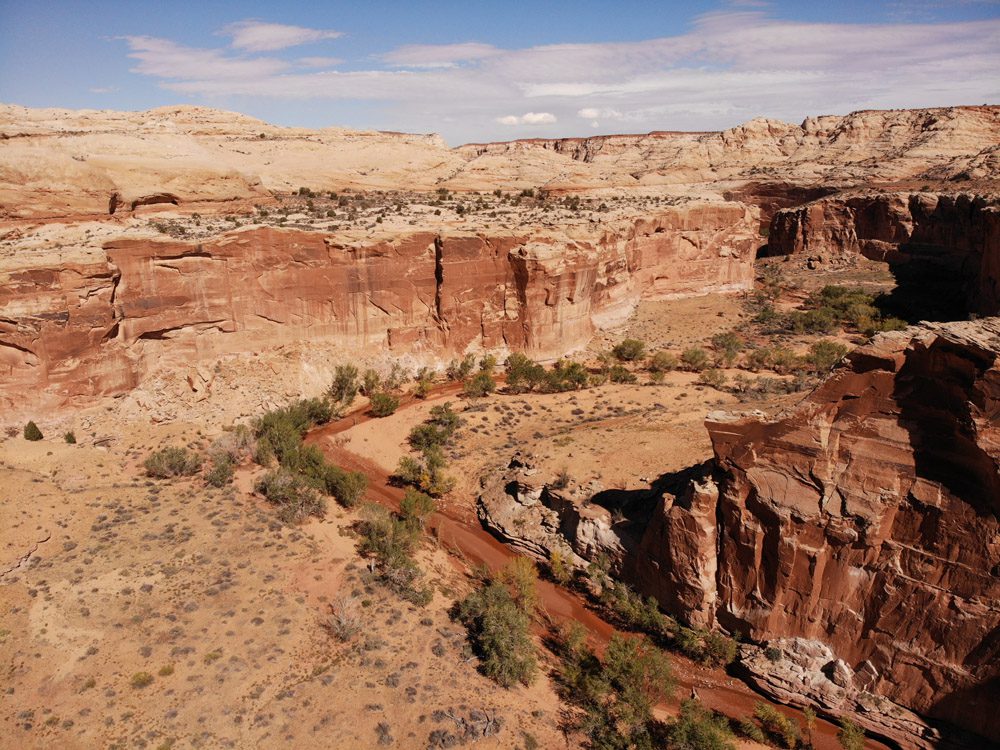
The trail’s highlight is the Great Gallery, with its life-sized human figures, intricate patterns, and impressive use of color.
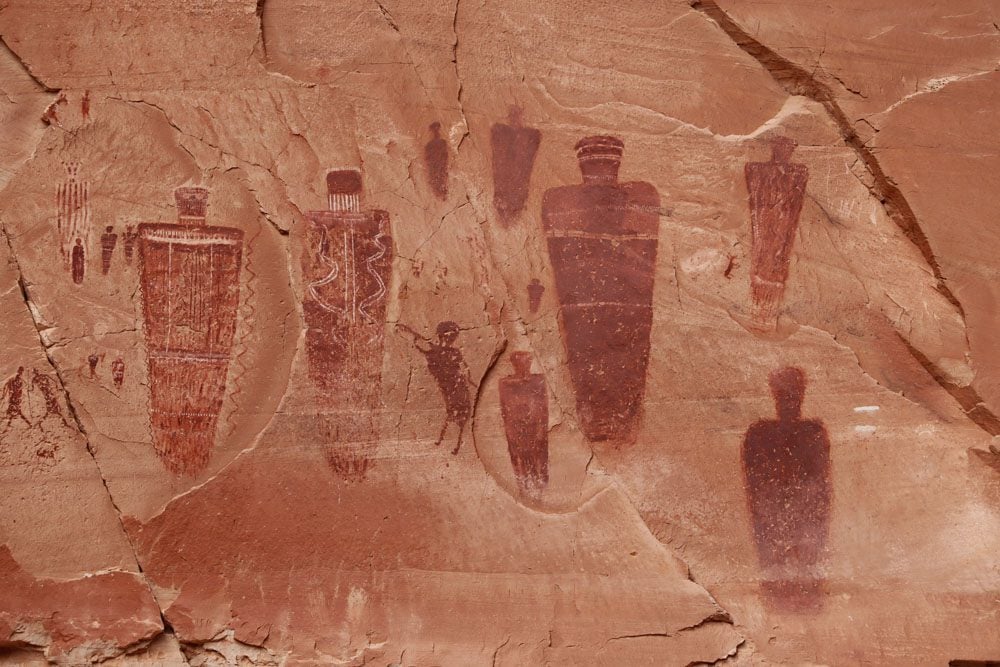
The Needles
Explore the Needles district on day three in Canyonlands. The Needles is the second-most visited district in Canyonlands, after Island in the Sky. It’s not far from Moab but not close either, so you’ll need to get an early start, especially if you want to hike one of its popular trails.
The Needles’ scenic drive is only 6.5 miles long, but it does offer several stops and access to short hikes, the best of which is at Big Spring Canyon Overlook. If you’re not planning any extended hikes, spend the day casually driving the length of the scenic drive and completing short trails, such as the Cave Spring Trail and the Slickrock Foot Trail. However, the best way to see the famous needles is on long hikes that take between 5-8 hours, the finest of which is the Chesler Park Loop Trail.
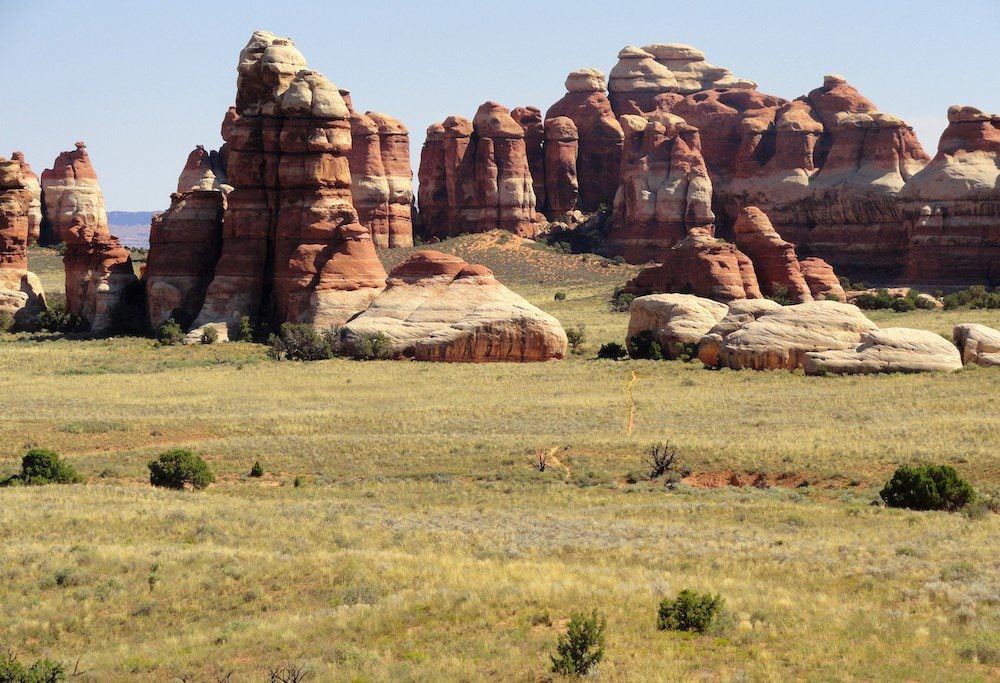
Here’s a detailed two-day Canyonlands itinerary with an in-depth look at Island in the Sky, Horseshoe Canyon, and the Needles. For a quick read, here’s a list of the top 10 things to do in Canyonlands.
What’s Next?
On this extensive two-week Utah itinerary, we covered all national parks that collectively form Utah’s “Mighty Five” and also explored the lesser-known Grand Staircase-Escalante on what I am sure is a road trip you’ll never forget. But, before hitting the road, check out additional Southern Utah and Southwest USA travel guides.

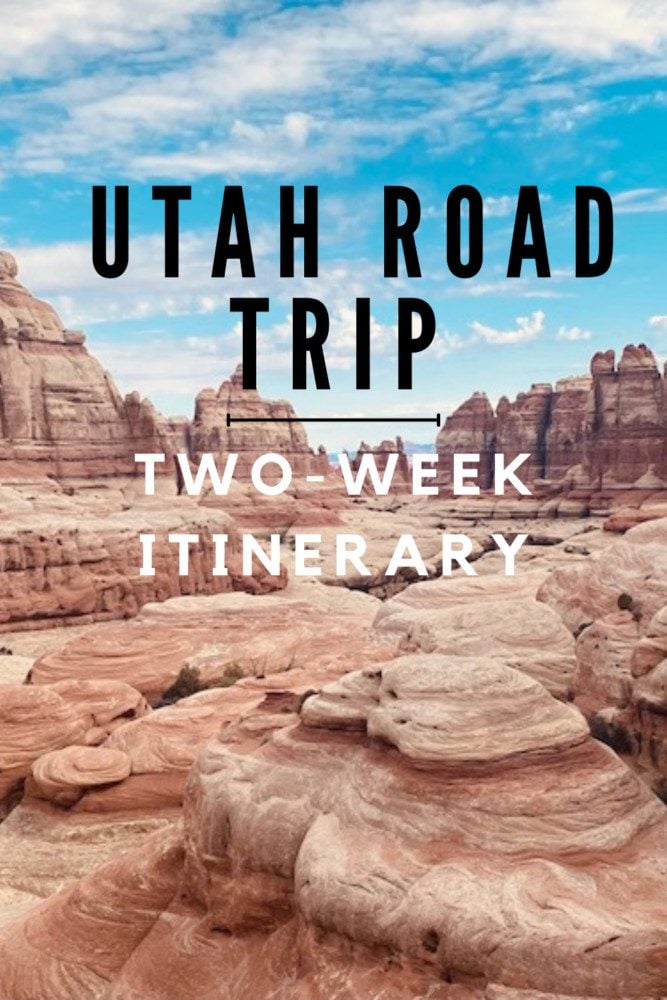
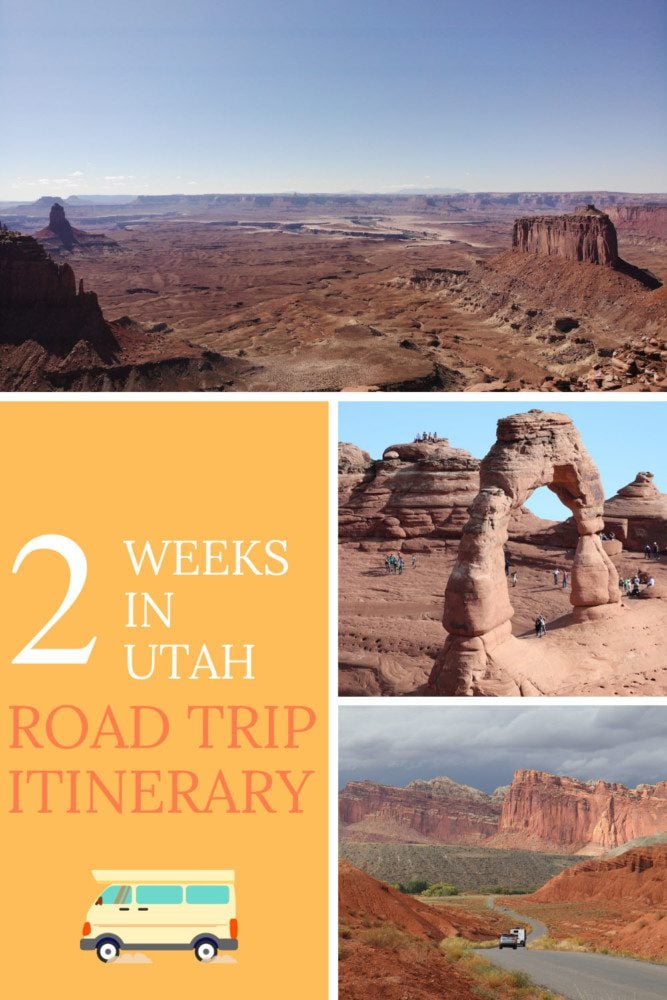
Pin These Images To Your Favorite Boards!




